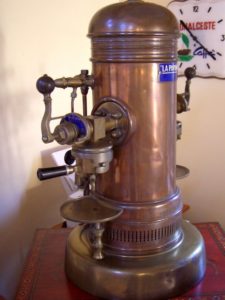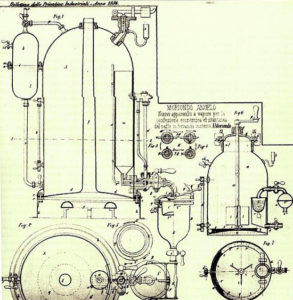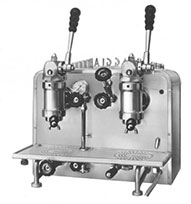*This post may contain affiliate links. As an Amazon Associate we earn from qualifying purchases.
The history of the first Espresso machine dates back to the beginning of the 19th century. A time for inventions indeed. Coffee was very popular and new in Europe and people were always interested in finding new ways to make brews and how to make the whole process go faster and not take so long. As a coffee business, you don’t want to be swarmed with people at all times, you need something quick. Many inventors in Europe saw this as their time to shine.
Image Source: http://www.smithsonianmag.com
Pictured above, is the first patent of the espresso machine. This particular patent model of the espresso machine was invented by Angelo Moriondo. Inventors main concerns were dealing with how long it took for coffee to brew, so like this model, they tried to find a quicker way with steam machines. Having a larger water boiler, meant that more water pressure could be pulled throughout the machine, and that meant a quicker process. Other than this patent model, Moriondo never went on to create an actual machine. He is not credited for anything other than this patent where other inventors took it as something they could improve upon and actually create.
As you can see, this was the next design for the espresso machine. The creator for this patent was Luigi Bezzera, who actually studied Moriondo’s model and found things that he could improve on. From this patent, Bezzera began putting his model to life. He created a large boiler that would reach high temperatures for the water to boil, and once it reached a certain temperature, the steam would break through a clump of ground coffee, which would then create the “espresso shot.” The main problem that Bezerra faced however, was using a flame as his only heat source. It worked, but it wasn’t always giving the same outcome which was a problem. Bezerra wanted someone to invest in this machine and help him get started with a business because it simply wasn’t something he could do on his own. It wasn’t until the year 1903, that someone by the name of Desiderio Pavoni, invested in Bezerros patents. Pavoni really improved the release valve for the water pressure, which made it a lot less messy of a machine. Both men gave their ideas and improvements towards this machine to make it as well rounded as they could.
In 1906, this invention was put out to the world. Bezzera and Pavoni introduced their machine at the Milan Fair as you can see in the picture above. After this however, Bezzeras name started to fade out and Pavoni was the only one really being recognized for his works. Even though the initial patent that they both worked from was Bezzeras. Pavoni went on his own path, continuing to make the name of his work very well known to all around. He had his own workshop with people that were creating replicas of this machine, and they began to grow incredibly in Italy after this. This was a very important time in history because it was considered the first step towards espresso machines in that day.
Throughout the years, things started to grow and also replace one another such as; electricity and gas. Come time for the 20th century, the espresso machines had shrunk in size incredibly and were much more developed. Pavoni continued to work on these machines but by his side was a man named Pier Teresio Arduino. Arduino was Pavoni’s main competitor who was seeking a way to make an espresso machine without relying on steam. Again, a quicker process. The difference between these two inventors was that Arduino had business experience and he knew how to get his model marketed to everyone. By 1920, Pavoni’s name started to die out because Arduino had built a bigger empire of Espresso machines and because of this, his ideas were known now all throughout the European country.
Achille Gaggia was the first person to make an espresso machine that didn’t use two bars for brewing like other inventors had. This made the machine much more efficient. He also created cylinders to use them for boiling which would eliminate space and make the machine much more smaller. This in turn made the water pressure even higher, which was needed for a quicker process. Gaggia also created levers for this machine, which made it a kind of its own at the time and set the floor for future espresso machines.
Above is a picture of the modern day espresso machine. As you can see from start to finish, it has shrunk in size drastically from the beginning. Years up until now, people have modified its look as well as what goes into it. The espresso machine started from the want to find a quicker coffee brewing method and to that it succeeded. Espresso machines are used everyday in big coffee companies, and even in people’s homes. It’s incredible how far it has come, and who knows where it will be years from now!







